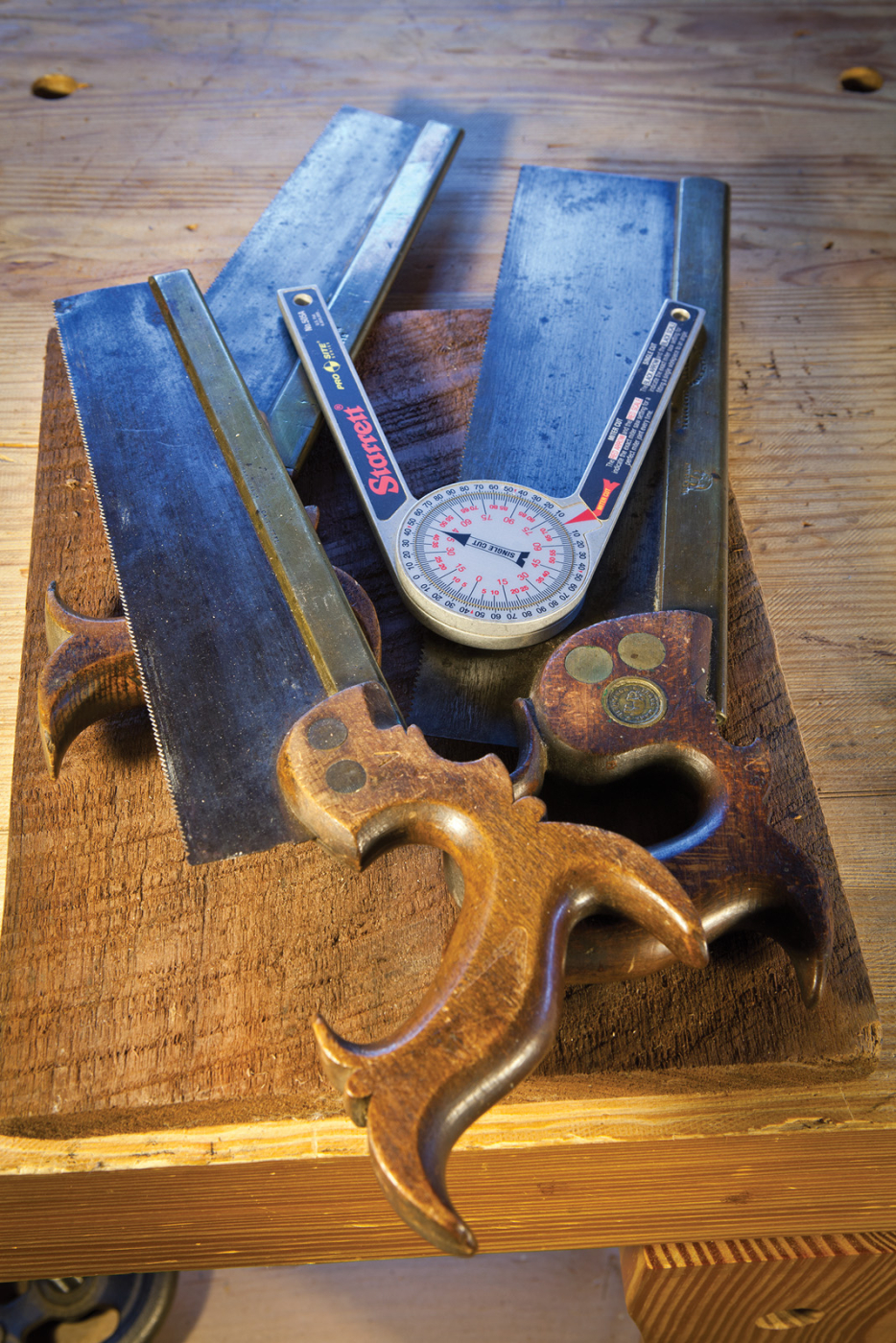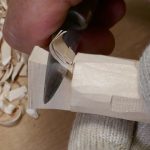We may receive a commission when you use our affiliate links. However, this does not impact our recommendations.

Choose wisely. While you can get used to most any saw and do good work, select a saw that helps channel your energy properly and you’ll do good work more easily.
Discover what really matters when choosing a handsaw.
You don’t have to be a saw maker to think about saws like one. Some of the most important decisions made when making a saw get surprisingly little attention from those who buy them.
Take hang angle, for example – that’s the angle formed between a saw’s grip and its toothline. I don’t think hang angle is discussed as much as it should be or in sufficient depth. Some explanations of it just plain miss the mark. Far more attention is given to how hang angle has evolved historically.
That’s interesting, but what about hang angle as it pertains to you right now making things in your shop? How much do you really know about it? Do you understand it well enough that you could determine a saw’s hang angle if you were told to calculate it from scratch?
The truth is, it takes little to make a saw that is functional. The earliest saws were little more than rocks with serrated edges. The real artistry in saws is in their refinement. The ultimate test of any saw is not whether or not it functions, but how well it functions.
You can (and should) evaluate that simply by using a saw. But the better you understand saws, the better you will understand what you are experiencing when you use them. You’ll know why they feel the way they do.
Let’s examine hang angle from the saw maker’s perspective.
 Understanding Hang Angle
Understanding Hang Angle
Simply put, hang angle is the deepest piece of architectural geometry a saw possesses. When you push a saw, the force travels in the direction the grip is facing. That angle has a profound effect on how well a saw cuts. If the grip is angled downward too steeply, the teeth at the toe do not have enough energy behind them, and teeth farther back are pushed down into the wood instead of forward through it. The teeth at the rear will stick or perhaps even jam in the work if the angle is severe enough.
If, on the other hand, the grip is at too shallow an angle, the energy you apply will not be balanced behind the saw’s cutting action. Getting the energy directly behind the saw’s teeth is not the same as putting it behind the saw’s cutting action. More on that momentarily. The net effect of a saw with too shallow a hang angle is a saw that feels strangely disconnected from the sawyer and that lacks power.
In either case, the saw does not cut its best by simply pushing the handle forward. The sawyer will instinctively apply different types of body English to correct for the poor geometry.
For example, when the grip is angled too shallowly, you’ll find you rock your wrist forward with each stroke to create a more aggressive cutting action at the toe. When the grip is pointed downward too steeply, you will find you subtly keep track of the pressure you apply at different points along each stroke in order to keep the saw from jamming.

No compensation. A good hang angle allows you to concentrate on your work without the distraction of compensating for your tool.
Even if you don’t consciously realize it, your skill and attention are being diverted from the work itself in order to overcome the saw’s shortcomings.
You could posit a general rule from this: lack of thought when making a tool results in distraction when using a tool.
To remedy either hang angle problem, the solution is the same. The force applied to the saw must be balanced behind the cutting action of the teeth. What exactly does that mean, though?
A Saw’s Cutting Action
As saw teeth move forward through wood, they also descend through it. The blade moves in both directions at once. You might suppose that the only reason the blade descends through the wood is because wood is removed as the blade is pushed forward – that downward movement is nothing but a by-product of wood removal. But that isn’t entirely true.
The teeth do remove wood when pushed forward, yes, but they are not just pushed forward. The saw is pushed at an angle that channels the energy both forward and slightly downward. Downward pressure propels the teeth into the wood more aggressively than if the teeth were pushed only from behind. So the downward movement is in fact part of the cutting action. The cutting action is compound. Balancing the energy supplied to the saw behind the cutting action is a matter of finding the trajectory that provides just the right mixture of forward and downward pressure.

Sweet spot. The correct cutting trajectory is the perfect balance of forward and downward pressure.
Every saw has a sweet spot behind which the energy you supply can be balanced – it is applied neither too steeply nor too shallowly. No body English is required. Saws that are the most comfortable and that cut the most effortlessly are precisely the ones that seem to “know” what to do with the force applied to them. All you have to do is push.
Sometimes you will hear people say that a saw should not require any downward pressure to use; that applying downward pressure is required only if the saw is dull; and that the only downward pressure required to use a saw should be provided by the weight of the saw itself.
In fact, all handsaws and backsaws require some measure of downward pressure. Insisting that the weight of the saw be the lone source of downward pressure is arbitrary – if you get it from there, you may as well get it from elsewhere. The weight of the saw is not even the best place from which to get the downward pressure required – the weight presses straight down.
A saw configured to get all its downward pressure from a heavy back feels like you are pushing and steering something from behind to which the handle is not entirely connected.
It isn’t about how sharp the teeth are – the sharpest teeth still won’t bite as aggressively without some downward pressure. It’s like having a razor-sharp carving tool and expecting it to cut without actually being pushed into the wood. Or expecting to push a wooden handplane from behind without getting any weight down over it. A saw can cut under the impetus of its own weight, but that is not even close to the best way to design or use a saw.
It is far more advantageous to account for downward pressure in the hang angle itself – so that simply pushing the handle forward not only pushes the teeth forward, but pushes them forward and slightly down.
Find the Balance Point
This is not quite the end of it, though – let’s look a little deeper.
If you think for a moment about the finest saws you have ever used, the facility with which they cut is not in fact characterized by a sheer lack of resistance. There is a low-grade resistance present that is perpetually generated and overcome as the saw is in motion. The ease with which the saw overcomes this resistance becomes your perception of how effortless the saw is to use.
The idea is to use hang angle to find the point at which the saw is ever so slightly challenged. This is another way of describing the balancing point we were talking about a moment ago. This small amount of resistance gives the saw just the right amount of feedback from the wood. This feedback, in turn, makes the saw feel solid and cohesive.

High & low. Notice the difference between the hang angles of the image above against the image below. The one below has a hang angle that is far too shallow; it directs your energy up away from the saw’s teeth. I suspect that is why this vintage saw is in such good condition – nobody liked using it.

You can sense the parts of the saw to which your hand is not literally connected. When you can sense the integrity of the tool like this, your thoughts are able to reach through it to the work. The tool feels more responsive.
So hang angle does much more than propel the saw through the wood – it affects everything from how effortless the saw feels to use, to how cohesive it feels, to how responsive it feels. It establishes a direct line of communication from the user through the saw to the work. There is nothing more important than hang angle.
So how do you “calculate” hang angle? It’s geometry, but you don’t need any numbers. Prescribed notions about numerical values for it aren’t that meaningful. There are too many variables in motion. You are much better off just “calculating” it by feel and by eye. How do you do that? It’s easier than it sounds. There’s really no substitute for experience and careful observation. Study every saw you come across. Decide what you think about its geometry and cutting action. With a little practice, you can become very good indeed at sensing how well or poorly a saw will cut.
“Calculating” hang angle for a saw you are designing is really just the reverse of evaluating the hang angle of an existing saw. You simply combine the blade and handle at an angle that you might otherwise admire if you found it on an existing saw.

Two very different hang angles. All of the variables in motion make each type of saw something of a separate art.
The really interesting part is that there is no single right answer – the sweet spot is not a pinpoint; it’s more of a range. The saw will feel a little different depending on where you land within that range. Relatively small degrees by which a handle is rotated can make a big difference in how a saw functions and feels.
It doesn’t take much for a saw to develop its own personality and feel. Imbuing each saw with its own touch of personality is what making saws by hand is all about.
Blade Shape Matters
Let’s look at a handful of variables that get factored intuitively when “calculating” hang angle. The orientation of the grip to the blade is only part of the story. The shape of the blade matters too.
The longer the blade, the lower the hang angle must be – meaning the shallower the trajectory needs to be. The energy supplied needs to get behind the cutting action all the way down at the toe of the saw. Otherwise it is like taking a grip made for a shorter saw and trying to push a longer saw with it. The teeth at the toe will cut, but they won’t have much leverage behind them. Also, as mentioned earlier, you run the risk of jamming the teeth into the wood farther back along the blade closer to the handle.
The taller the blade, the steeper the hang angle must be. If the hang angle is too shallow, the force you apply is too high and doesn’t get sufficiently behind the teeth – it’s like using a handle oriented to an imaginary toothline buried somewhere within the field of the blade. The teeth will cut, of course – saw teeth will cut so long as they are pushed forward; but the force you are applying to the saw won’t feel connected to those teeth. Nor will it do a very good job of pushing them forward. The teeth at the toe of the saw will tend to dig in and grab. This is because the force is too high – it’s a force that would cause the saw to topple forward if it could, like a bicycle rider about to go over the handlebars.

Grip placement. Notice how, with these taller and longer blades, the handles have a curious “jog” along their upper edge, so that the upper edge of the blade is supported while the grip is placed lower.
Some blades are tall enough that it is not possible to get a really good hang angle without lowering the placement of the grip. Grip placement is important for all saws – you just don’t notice it as much with saws whose blades aren’t tall because the relative vertical compactness of these saws fosters good grip placement in the first place. With tall saws, if the grip is left high, you either wind up with that toppling effect described above, or you wind up with the force being aimed too steeply downward.
Trying to dial in the hang angle on a saw whose grip is too high is like trying to answer a test question that has no right answer. The solution is to alter the handle design to lower the grip on the handle itself. You see this commonly with handsaw handles.
Inclined (or Raked) Blades
One last variable warrants attention when discussing hang angle: Not all backsaw blades are rectangular. Some are inclined, or raked, from toe to heel, so they are taller at the heel than at the toe. Because hang angle is the relation of the grip to the tooth line, you can manipulate hang angle by altering the tooth line as well as the handle. If you leave the handle alone and incline, or rake, the blade, that is the equivalent of having rotated the grip up higher.

Blade rake. This is one reason that numbers don’t matter. These saws have the same numerical hang angle, but they won’t feel identical in use. The saw with the raked blade is more compact.
Consider two saws on which the hang angles are the same, but one blade is raked while the other is not. On the one hand, they are identical. But on the other, the saw with the raked blade is more compact; its grip sits lower in relation to the saw’s weight.
This is important, because a more compact saw will feel more cohesive and responsive.
This is why it’s not entirely meaningful to compare only numerical values of hang angle. It matters how the blade is shaped and how the grip is oriented. Hang angle is not just about geometry; it’s about how a saw feels.

Fundamental character. Blade rake is like hang angle – there is no single correct value for it. A saw maker’s decisions become a saw’s fundamental character. All three of these saws are quite nice, and each is a little different.
If a more compact design is preferable, why not dramatically rake all saw blades and rotate the grip down as low as possible? Manipulating the blade is like a lot of things: It is good in moderation. Overdoing it will result in a saw that doesn’t feel balanced. A grip too low in relation to the saw’s weight will not feel as connected to that weight as a grip left up a little higher.
Conclusion
Admittedly, there is a lot more to thinking like a saw maker than I can possibly squeeze into an article of this scope. But I hope this at least gives you food for thought the next time you try a new saw or contemplate one you already own.
Hang angle is immeasurably important. A thoughtful saw maker gives a lot of thought to matters such as this. He or she anticipates the saw in use and designs a saw that reveals its true worth when used. Trust me – the thoughtful maker thinks about the thoughts of the saw user.
But just the same, a thoughtful saw user can gaze back through the saw at the thoughts of the maker. Your experience as a sawyer will deepen for doing so. It would be hard to imagine a better place to start than with hang angle.
Here are some supplies and tools we find essential in our everyday work around the shop. We may receive a commission from sales referred by our links; however, we have carefully selected these products for their usefulness and quality.









